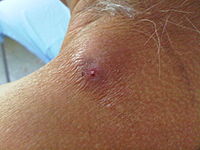
Photo from wikipedia
This article discusses the ability of the sarcophagid fly Sarcophaga argyrostoma (Robineau-Desvoidy) to exploit various food sources. These include living, freshly dead, and highly decayed remains. It also considers the… Click to show full abstract
This article discusses the ability of the sarcophagid fly Sarcophaga argyrostoma (Robineau-Desvoidy) to exploit various food sources. These include living, freshly dead, and highly decayed remains. It also considers the factors affecting larval thermogenesis and compares S. argyrostoma with Lucilia sericata (Meigen). In addition, the ability of S. argyrostoma to colonise buried baits, those out of reach, and those protected by bandaging is considered. Both fresh and decayed liver stimulated ovoviviposition by S. argyrostoma and oviposition by L. sericata. Even liver that had decayed for 840 days supported larval development by both species to adulthood. Thermogenesis during larval development was dependent upon larval density. There was no difference in thermogenesis characteristics between S. argyrostoma and L. sericata or between diets of fresh liver and fresh minced pork. Thermogenesis was less pronounced on 840-day-old liver than on fresh liver but was still dependent upon larval density and there was no species effect. When starved, third instar S. argyrostoma larvae did not exhibit cannibalism or attack third instar L. sericata larvae. Sarcophaga argyrostoma adults could detect fresh liver baits buried at 20 cm in loose soil and ovoviviposited on the soil surface. The larvae then rapidly crawled through the soil to reach the baits and completed their development below ground. Sarcophaga argyrostoma also colonised baits that were at least 5 cm out of reach by dropping larvae onto them. They could infest baits through gauze bandages but not wound dressings. The adults would not ovoviviposit on living invertebrates but dead snails and dead L. sericata third instar larvae were infested and supported larval growth to adulthood. The adults were willing to ovoviviposit on human faeces and it supported larval growth to adulthood. Human urine stimulated very limited ovoviviposition and the larvae all died shortly afterwards and without developing. They did not ovoviviposit on banana or melon.
Journal Title: Forensic science international
Year Published: 2020
Link to full text (if available)
Share on Social Media: Sign Up to like & get
recommendations!